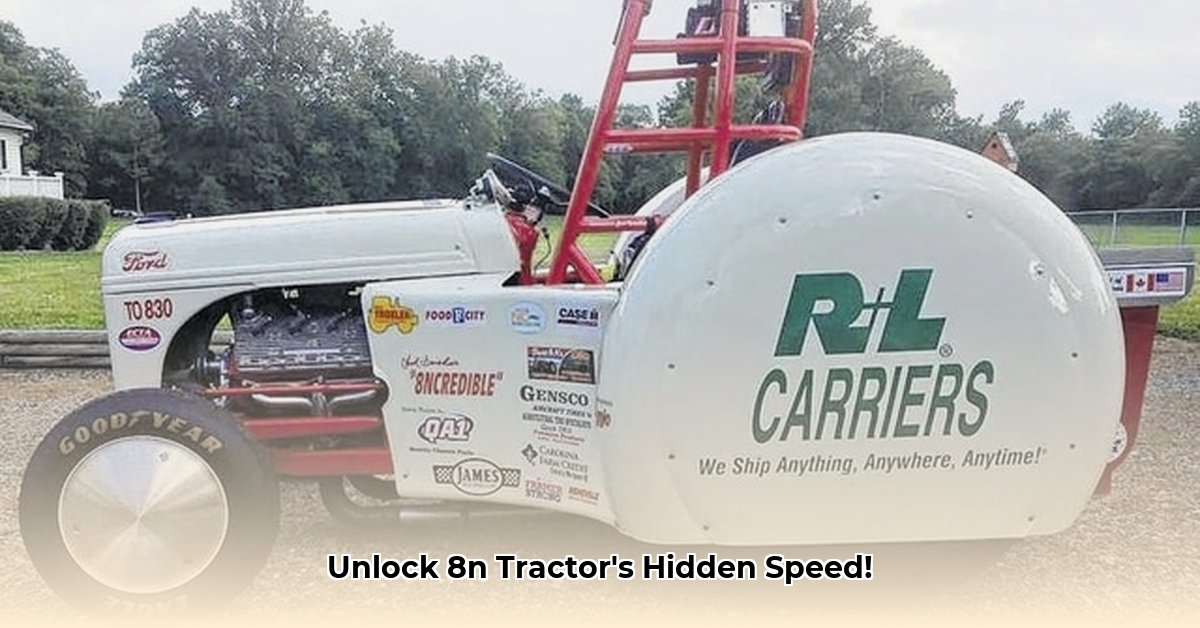
8N Tractor Top Speed mph: Understanding the Variables
Just how fast can your Ford 8N tractor go? The answer isn't a single number. The top speed of your 8N depends on several interconnected factors, impacting both its potential and, critically, your safety. This guide will explore these factors, offering practical advice for safe and effective operation. For more tractor speed comparisons, check out this helpful resource: Tractor Speed Data.
Factors Affecting Your 8N's Top Speed
Several key components influence the maximum speed your 8N can achieve. Understanding these is crucial for both performance and safety.
Transmission: The Heart of the Speed
Your 8N's transmission is the primary determinant of its speed. A standard transmission typically limits the top speed to 10-12 mph, depending on tire size and engine condition. Adding an aftermarket overdrive (like a Sherman kit) significantly boosts this, potentially reaching 14-25 mph. However, remember that older tests using standard 8Ns with typical tires recorded speeds around 11.92 mph. This highlights the significant variance based on individual factors.
Tire Size: Rolling Towards Higher Speeds
Larger tires increase the ground covered per engine revolution, directly affecting top speed. However, using oversized tires can negatively impact steering, braking, and the tractor's overall stability. This is akin to changing a car's tire size without recalibrating the speedometer – readings become inaccurate.
Governor Settings: Engine's Internal Speed Limit
The governor controls the engine's maximum revolutions per minute (RPM), acting as a built-in speed limiter. Tampering with the governor without specialized knowledge is dangerous, possibly causing significant engine damage. Think of it as removing the speed limiter on a car – potentially catastrophic.
Engine Health: Peak Performance Requires Maintenance
A well-maintained engine plays a significant role. Regular maintenance, including oil changes and tune-ups, ensures optimal engine performance and, consequently, a slightly higher top speed. A healthy engine translates into better responsiveness, similar to a car performing better with regular servicing.
Typical Speed Ranges for Your 8N
Based on various sources including historical data and owner reports, here’s a general guideline:
| Transmission Type | Typical Speed Range (mph) | Considerations |
|---|---|---|
| Standard | 10-12 | Varies with tire size, engine condition, terrain, and load. |
| Overdrive | 14-25 | Significantly faster, demands increased caution due to braking system limitations. |
Remember, these are estimates. Self-reported speeds vary widely due to the numerous influencing factors.
Safety: The Non-Negotiable Factor
The Ford 8N's braking system is not designed for high speeds. Higher speeds dramatically increase stopping distances, posing significant safety risks. Modifications to the governor or other critical systems are strongly discouraged unless undertaken by experienced mechanics, similar to attempting complex automotive modifications without expertise.
Practical Advice for Safe 8N Operation
Here’s how to ensure safe and efficient operation:
Prioritize Regular Maintenance: Regular inspections of brakes, fluids, and engine components are non-negotiable, particularly before operating at higher speeds.
Avoid Unnecessary Modifications: Resist altering the governor or other critical systems without expert guidance. The potential for damage far outweighs the minimal speed gain.
Choose Appropriate Tires: Use the correct tire size specified in your owner's manual. Incorrect tires compromise steering, braking, and overall stability.
Gradual Acceleration and Deceleration: Avoid sudden acceleration or braking, minimizing stress on the tractor's components. This approach extends the lifespan of vital systems.
Tailored Advice: Buyers, Owners, and Hayride Operators
Here's specific advice based on your 8N usage:
Potential Buyers: Thoroughly inspect the brakes and transmission before purchase. Factor in the potential for future overdrive upgrades.
Current Owners: Regular brake maintenance is crucial. Understand your governor's limitations. Avoid modifications without expert help.
Hayride Operators: Prioritize safety. Maintain moderate speeds, and ensure proper safety equipment (seatbelts, etc.) is used.
Responsible operation is paramount. While exploring the speed potential of your 8N is tempting, prioritize safety. A well-maintained and safely operated tractor is far more valuable than a few extra mph.